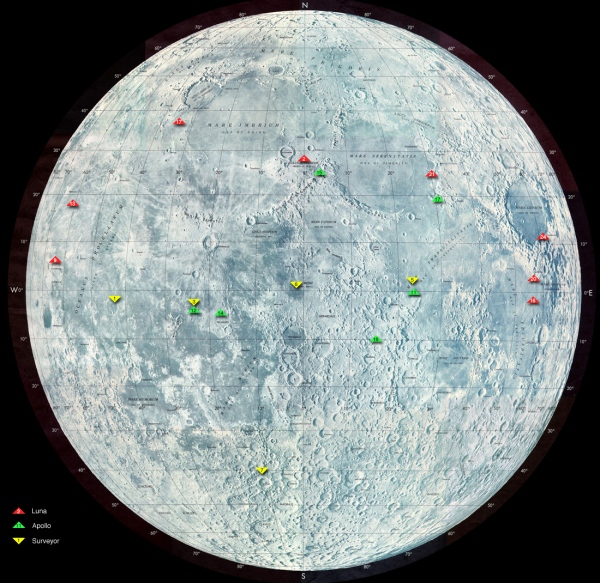
At 18:45:30 UTC on February 3, 1966 the Soviet Luna 9 spacecraft made the first successful robotic soft landing on the Moon. Seven hours later it began to transmit images from the lunar surface down to Earth. The image above comprise the first two frames of the first of three panoramas captured by Luna 9’s cycloramic camera, making the left half the first picture taken on the surface of the Moon.

Launched from Baikonur Cosmodrome on Jan. 31, 1966, the 22-inch-wide (58cm) spherical ALS capsule landed on the Moon via an inflatable cocoon of air bags west of the Reiner and Marius craters at the edge of the Ocean of Storms (see the map below of lunar landing sites.) Luna 9 beat America’s Surveyor to the Moon by about four months. Its landing was harder than that of Surveyor, but still soft enough for its camera and radiation detector to survive and do their jobs. Luna 9 was the 12th attempt at a soft-landing by the Soviet Union.
The first images were captured and transmitted to Earth seven hours later (on Feb. 4 UTC) via analog FM video. The Soviets did not initially share their images with the rest of the world, but England scooped the Soviets by intercepting radio signals carrying Luna 9 photo data at Jodrell Bank radio observatory and releasing a picture—although with distorted processing—before the USSR could present its official versions!
“Chained by secrecy and bureaucracy, Soviet scientists were able to present properly formatted images only a day later, along with their consternation toward their enterprising colleagues abroad.”
— Anatoly Zak, RussianSpaceWeb.com
The picture that was intercepted and published by English astronomers was a portion of the second panorama taken by Luna 9. It beat any part of the actual first panorama to the newsstands, but couldn’t have been the first picture taken (even if it was the picture much of the world saw first and most remembers today.)

In addition to the surface images, perhaps the most important discovery of the Luna 9 mission was establishing that a foreign object would not simply sink into the lunar dust and that the surface of the Moon could support a more massive lander. (Yes, this was a real concern to both Soviet and American scientists.)
Last contact with the Luna 9 spacecraft was at 22:55 UTC on February 6, 1966.

The Soviet Lunar program had 20 successful missions to the Moon and achieved a number of notable lunar firsts: first probe to impact the Moon, first flyby and image of the lunar farside, first soft landing, first lunar orbiter, and the first circumlunar probe to return to Earth. The two successful series of Soviet probes were the Luna (24 lunar missions) and the Zond (5 lunar missions).
Read more about the Soviet lunar missions here, and space historian Anatoly Zak has a great write-up on the Luna 9 mission and its immediate impact in the U.S. on his RussianSpaceWeb site here.
Sources: NSSDC/NASA Solar System Exploration, RussianSpaceWeb.com, and Don P. Mitchell